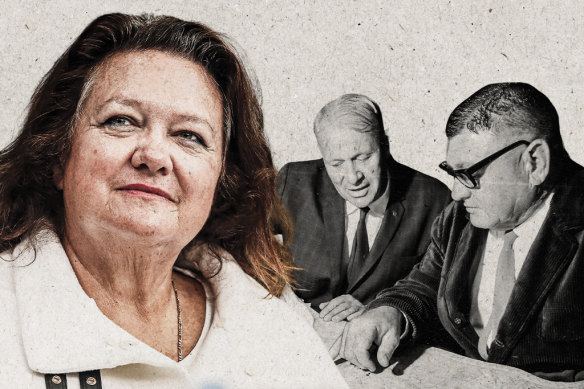Lawyers for Gina Rinehart’s Hancock Prospecting have savaged the 37-year-old bombshell letter a fellow mining dynasty hailed as proof the magnate knew she had to share her iron ore billions, branding it “peripheral” evidence made redundant by a subsequent deal.
The letter Lang Hancock penned to his daughter Rinehart shortly after the death of his business partner Peter Wright set out the division of assets and his intention to retain several tenements, now home to four operational mines known as Hope Downs, jointly for the “Hanwright” partnership.

Gina Rinehart and her company Hancock Prospecting, started by her father Lang (far right), is defending claims to its Hope Downs iron ore tenement in the Pilbara from Wright Prospecting, started by Peter Wright (left).Credit: Composite image
The letter was dubbed “significant evidence” by Wright Prospecting’s lawyer Julie Taylor early in the high-stakes civil trial, in which Wright’s descendants are claiming a slice of Hope Downs’ royalties under a 1980s deal to share equally in the spoils of partnership assets.
But Hancock Prospecting’s lawyer Noel Hutley rubbished the characterisation, insisting it was, at best, of the most “peripheral relevance”.
“If anything, it supports our case to the extent it is even relevant and we embrace it,” he told the court.
“It confirms Lang’s understanding that there was an asset of real value to seek to obtain rights over.”
Hutley said Lang’s letter was made redundant by a deal he signed the following year with his late business partner’s son Michael, in which they agreed to divide up the partnership’s assets.
And the court heard Lang was emphatically opposed to anything other than a clean break, with a second letter read in court showing he foresaw the lengthy battle the former pioneers’ heirs were now engaged in.
“Provided we can make a total clean up package division of Hancock and Wright, so as to not leave grey areas for our respective heirs to argue about,” Lang wrote.
This came just years after Lang had written to his former business partner urging a fresh deal with a clearer split, insisting a previous iteration had “so many strings attached” that it was “paralysing” his solo mining pursuits.
Hutley spent Hancock Prospecting’s second day of opening submissions pointing out what he deemed fatal flaws in Wright Prospecting’s reading of the 1987 deal clauses their case hinged on.
He labelled much of the case levelled against Hancock Prospecting at the hands of Wright Prospecting “legally incoherent” and said the firm’s reading of the clauses amounted to an “impermissible redrafting” of the deal.
Hutley also rejected claims the partnership had worked to bring Hope Downs to production, pointing out detailed exploration did not take place until a sharp iron ore price hike during the so-called “China boom” made it commercially worthwhile.
Wright Prospecting maintains that it never relinquished its partnership interest in the assets, but has been denied its rightful share.
Hancock Prospecting also attacked a claim by DFD Rhodes, the firm of pioneer Don Rhodes, which is seeking a 1.25 per cent royalty cut, that it played a critical role in the lucrative iron ore deposit’s discovery and allocated staff resources.
A transcript of a May 1972 meeting was tendered as evidence to support Hancock’s position, in which Rhodes’ geologist Graeme Hutton admits he had no role in the discovery of the deposit.
Hutley claimed that was evidence “of the most powerful kind”.
The trial continues.
The long-awaited legal showdown has seen Rinehart pitted against the billionaire heirs to Wright’s empire, including his daughter Angela Bennett and his son Michael Wright’s children, Leonie Baldock and Alexandra Burt.
Wright argues it is entitled to a half-share of the royalties streaming out of the sprawling Hope Downs tenement Hancock Prospecting co-owns with operator Rio Tinto, including Hope Downs 1, 2 and 3 and East Angelas, now home to four operational mines deemed the country’s most successful.
But Wright’s descendants and DFD Rhodes’ firm aren’t Rinehart’s only legal opponents, with her eldest children, John Hancock and Bianca Rinehart, also claiming a stake in the legacy.
Our Breaking News Alert will notify you of significant breaking news when it happens. Get it here.